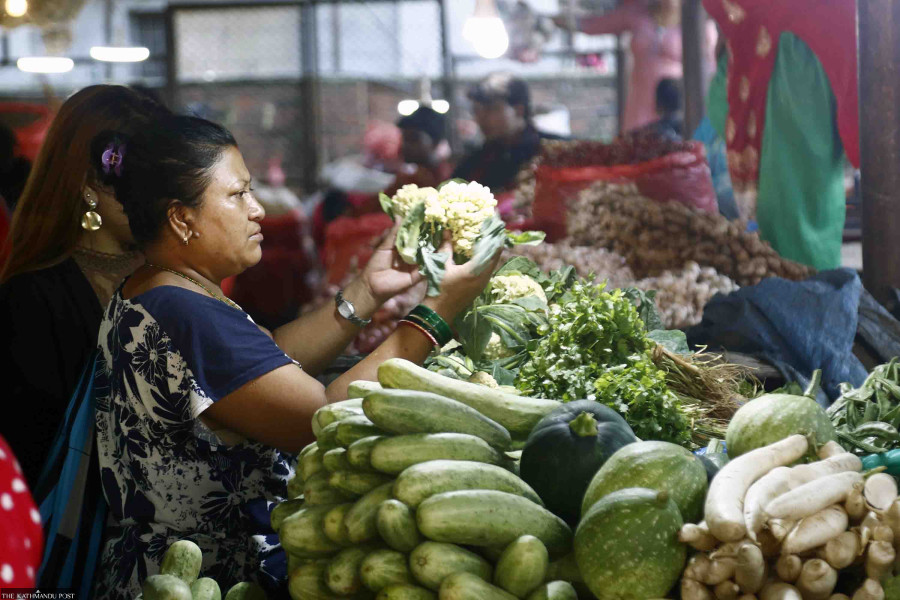Money
Stubborn inflation haunts Nepali consumers
Higher-than-expected inflation has been reducing household purchasing power and dragging growth.
Krishana Prasain
The government, following a dramatic surge in inflation last year, has targeted taming the inflation rate this year.
But the data of the last three months tells a different story.
There are no proper measures adopted by the government yet to address overheating inflation, economists say.
According to Nepal Rastra Bank, the country’s central bank, the year-on-year consumer price inflation rose to 7.44 percent in mid-March compared to 7.14 percent a year ago.
Economists say that since inflation has risen from a higher base of 7.14 percent, Nepal is passing through hyperinflation, an extreme case of inflation. They said that higher inflation rates are more prevalent in Nepal because the country often lacks sufficient data and transparency.
“Once the prices go up, we don’t see them falling immediately,” Yadav Sharma, 67, from Bhaktapur, told the Post.
“I don’t see the government taking any drastic measures to control inflation.”
Taming inflation should be the top priority for any country as risks to growth and investment outlook could rise if price pressures persist at high levels.
“There is no policy intervention to control prices. If the prime minister feels prices are expensive, he asks them to be reduced but there are no policy measures to control the prices,” said Sharma.
Prime Minister Pushpa Kamal Dahal has on different occasions ordered the concerned agencies to reduce the prices. One such example was petroleum prices.
“But that’s a misuse of power. The government pays little attention to the root of the problem. Superficial measures will not solve the problems faced by the general public,” said Sharma, a retired teacher.
Food and beverage inflation increased to 5.64 percent while non-food and service inflation rose to 8.87 percent in the first eight months of the current fiscal year.
The cereal grains prices increased to 14.35 percent in mid-March compared to the same period last fiscal year. The inflation on fruits increased by 7.93 percent, spices by 10.88 percent, and beverages by 7.17 percent in the review month. Inflation on restaurants and hotels increased by 14.09 percent.
Similarly, according to the central bank’s statistics, the prices of clothes and footwear increased by 7.03 percent; housing and utilities by 9.72 percent, furnishing and household equipment by 8.79 percent and health cost by 10.39 percent.
Transportation inflation rose by 13.23 percent; recreation and culture by 8.81 percent and education by 8.67 percent.
The World Bank said in its latest report that contributing factors to the price increase include higher vegetable prices associated in part with supply shocks in India; cereal grain prices triggered by India’s export ban on wheat and rice, higher transportation prices associated with the increase in global energy prices, and housing and utility prices.
The report said that higher-than-expected inflation would reduce household purchasing power and drag growth. Welfare recovery remains uncertain due to rising inflation and risks to agricultural production.
Life is becoming harder for low-income Nepali families because of rising prices.
As most of the commodities association is led by the cadres of various political parties and middlemen, they monopolise the price of goods, said Bishnu Prasad Timilsina, general secretary of the Forum for Protection of Consumer Rights-Nepal.
“The government is more inclined towards the welfare of middlemen rather than being sensitive towards consumer rights and their interests.”
The Department of Commerce, Supplies and Consumer Protection’s, a key government market monitoring body, effectiveness is in question, he said.
Economists said that the consumption of goods and services has declined in the market with the price hike. The prices of daily consumable goods like rice, lentils, edible oil, and vegetables, have been increasing and the price rise is not seasonal.
The dairy traders raised the price of milk on their own. The transport entrepreneurs increase the fare on their own. Nepal Oil Corporation increases prices on its own.
“No one questions them on the price hikes,” said Timilsina.
Petroleum prices have also not decreased even though the international market reported a decrease.
“The country is in the midst of political uncertainty again and this motivates the opportunists and unscrupulous traders to take benefit from such instability,” said Timilsina.
“Everyone knows that the demand for goods has declined in the market, which is mainly due to inflation, but the government is doing nothing,” said Govinda Nepal, an economist.
“People are controlling their spending due to inflation. If the government fails to address this inflation, the already slow Nepali economy will suffer,” he said.
He said that the government is tirelessly working to bring money into the market, but it has no plan to cool down inflation.
“The government and even the private sector is focussing on reducing the interest rate but no one has intervened in terms of controlling inflation which has been hitting the public really hard,” Timilsina told the Post.
For a country like Nepal, where instability rules, there are layers of middlemen who control the market and make goods expensive, says Timilsina. “None of the systems is working right now. It’s chaos.”




 12.88°C Kathmandu
12.88°C Kathmandu















